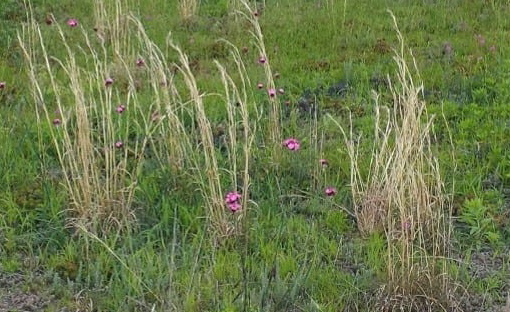

Dr. Gary Bates
Director and Professor
UT Beef & Forage Center
P: 865-974-7324
Broomsedge is one of those problems that show up every summer, and how to get rid of it is one of the most common questions that I get. Often people hope there is some way to use a herbicide to selectively kill the broomsedge out of tall fescue, but there aren’t any herbicides available for this. But all is not lost, there are things you can do to reduce or eliminate the broomsedge problems on your farm.
Understanding the plant
Broomsedge is a warm-season perennial grass, similar to other native grasses such as switchgrass and big bluestem. It does not produce a lot of forage, so it isn’t one of our desirable species for grazing or hay production. When you see the tan/brown stalks in the mid to late summer, those are actually the broomsedge seedheads. The fluffy seed produced by the plant are easily dispersed by animals or the wind. Broomsedge is relatively weak as a seedling and won’t compete well with more aggressive grasses such as tall fescue. This plant will green up in May, produce a seedhead in late summer, then go dormant during the late fall period.
Why did broomsedge move into your field?
Usually a good, thick stand of actively growing tall fescue will not have much broomsedge present. Anything that occurs to make the stand of tall fescue less aggressive will provide an opportunity for broomsedge to move into a field. If pH, potash, or phosphate levels get low, the fescue will be weakened, and broomsedge might get a foothold. If you mow too low or overgraze, the stand might be thinned allowing a spot for broomsedge. In order to keep broomsedge out of a field, or to get rid of broomsedge in a field, the idea is to outcompete it with the fescue. Here are steps to help with this.
- Correct soil fertility deficiencies. Step one is to fertilize and lime to make sure the tall fescue can grow and be competitive with the broomsedge. Remember that is isn’t always simply pH that is the problem. It could be low phosphate or potash levels. Make sure to provide enough nitrogen to encourage active tall fescue growth. The only way to know exactly how much lime or fertilizer is required is through soil testing. Contact your local Extension office for information on soil testing.
- Evaluate if the tall fescue stand needs to be thickened. If the tall fescue stand is thin, there may not be enough plants to cause competition to the broomsedge. If you have a 50 percent or more stand, you may need to simply drill more tall fescue in the fall to thicken the existing stand. If the stand is less than 50 percent, it may be best to spray and kill everything (including the broomsedge) and replant tall fescue in the fall.
- Use timely clipping to weaken the broomsedge. If the broomsedge is clipped at the right time, it will weaken the plant and help with the competition with tall fescue. It is best to clip twice, first in mid-July, when you see the brown seedheads, and then again in early September. Doing this will weaken the plants going into winter and cause a certain percentage of the plants to die. It won’t kill it all in one year, but over the course o 3 years or so, you should se a dramatic decrease in the broomsedge population.
Remember that the broomsedge did not move into the field in one year, and you won’t be able to outcompete it in one year. But a sustained approach over several years can help you solve this problem.